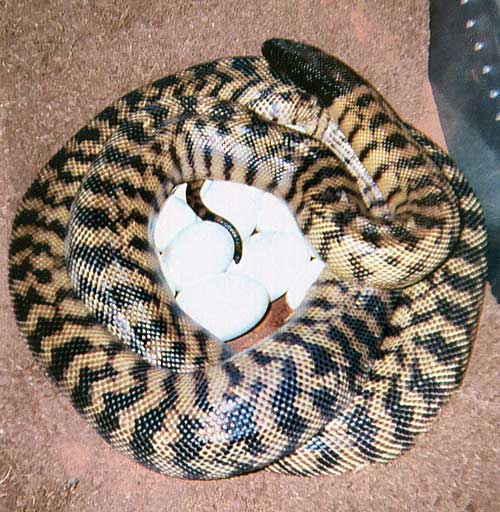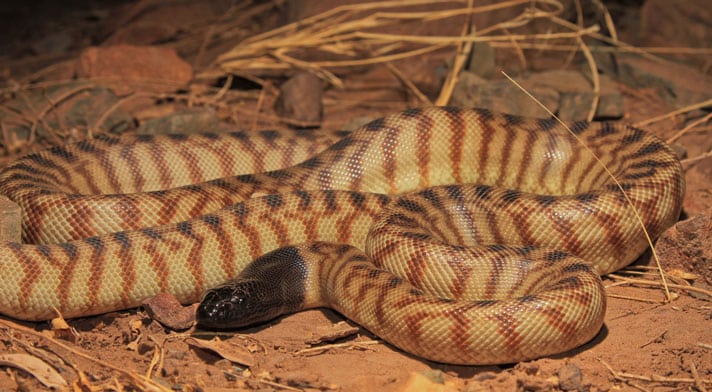Achieve success breeding the beautiful black-headed python snake.
Black-headed pythons (Aspidites melanocephalus), also called “tarpots” in Australia, are beautiful snakes known for their obvious black head and neck. They almost appear to have been dipped in black ink. The black-headed python’s head and jaws are long, with the head not much wider than the neck. The eyes are black, and the scalation is smooth and glossy. The background color ranges from a light gray to off white to a pale yellow or a light brown.

Photo by Mike and Isis Madec
It is recommended that a black-headed python be 4 years old before it is bred.
Found along the northern third of Australia, black-headed pythons live in a wide variety of habitats, from dry, rocky areas to wet forests. Adult black-headed pythons range from 5 to 10 feet long. Our animals here at Isis Reptiles range in length from 6 to 8 feet, with the males generally being smaller than the females by a foot.
The average age that we breed black-headed pythons is around 4 years old. Although we bred one at 2½ years old, we recommend waiting for the best chances of success. From our own observations, as the snakes grow larger in size, the clutch sizes they produce become larger as well. This does not mean, however, that animals should be overfed to attain larger sizes faster. Overfeeding will cause health problems and a shorter life span.
We feed our male black-headed pythons two small to medium rats every 14 days. Female black-headed pythons are fed three to four every 10 days. We feed only thawed-frozen food, because it is safer for the keeper and the snake.
Black-Headed Python Habitat
We breed our black-headed pythons in the same enclosure one of them normally lives in; we’ve had success placing the female with the male in his enclosure as well as vice versa. Habitats are 6 feet long, 2 feet tall and 3 feet wide. One side has a 13-inch heat strip that provides a hotspot of 95 degrees Fahrenheit. The rest of the cage has an ambient temperature between 78 and 80 degrees.
Each black-headed python habitat has an overhead UVB light on the warm side of the cage over the basking spot. We have observed that the male black-headed pythons tend to bask more often than the female black-headed pythons. Large hide boxes measuring 14 inches long, 20 inches wide and 12 inches tall are provided for both males and females, and nesting boxes are also provided for the females. We use a 50/50 mixture of moist Bed-A-Beast Litter and sand in these boxes. Hide boxes are placed on both the warm and cool sides of the cage. Having the hide boxes keeps the snakes content, and the moist substrate aids in shedding. The nesting box is placed on the hotspot. Drinking bowls just large enough for them to drink from, but not big enough to soak in, are provided.
We are located in Southern California near the coast, and the weather here seems agreeable to black-headed pythons. Our adults are placed outside in a large aviary measuring 24 feet long, 8 feet wide and 7 feet tall. We do this two or three times a week during the summer months to offer them natural sunlight. We wait until about four days after they have eaten, and then allow them to remain outside for several hours at a stretch to allow them exercise. They love to sunbathe. Soaking tubs are also provided at these times, as some of our pythons enjoy soaking on hot days.
When to Breed Black-Headed Pythons
Around October our black-headed pythons tend to slow down quite a bit. We’ve spoken with other breeders working with this wonderful snake species, and depending on where they are located, they breed their black-headed pythons up to two or three months earlier than we breed ours because of climate differences. This is something to be kept in mind when cycling these snakes.
We stop feeding our black-headed pythons around the middle of November. We keep them heated at the previously mentioned temperatures (95 degrees at the hot end of the enclosure; 80 at the cooler end) to completely clean out their digestive tracts. It’s very important to do this, as not doing so can cause digestive problems.
Three weeks after the black-headed pythons have eaten their last meal, we cool the snakes down to 68 to 70 degrees at night and turn off the heating strips. We still allow the room temperature to rise to 78 to 80 degrees for a 10-hour daytime period, and the hotspot remains at 95 degrees during the day.
Black-Headed Pythons: Introducing the Male to the Female
After three weeks of cooler night temperatures, we introduce male black-headed pythons and female black-headed pythons. We continue to lower the temperature at night. We have bred different males with a single female as well as one male with a female, and have achieved the same results. Sometimes a male is not interested in a female. If this happens, he is removed and replaced with another male.
A male black-headed python shows interest in a female by crawling along her back and tickling her back with his spurs. A female shows interest by being receptive to the male’s advances. This behavior generally means that copulation will soon take place.
The black-headed pythons are kept together until ovulation has taken place. Although there is no reliable way to tell if ovulation has occurred, a good rule of thumb is to remove the male when he no longer shows interest in the female. If successful ovulation occurs, eggs will be laid around 60 days later.
Incubating Black-Headed Python Eggs
Female black-headed pythons usually lay six to 20 eggs approximately 30 days after a post-ovulation shed. Do not remove the eggs until you’re sure she has finished laying all of them. When removing the eggs to the incubator, don’t rotate them. Keep their orientation the same.
For incubation, we prepare a covered plastic sweater box that is placed inside the incubator. The box measures 16 inches long, 11 inches wide and 5 inches tall, and it has four to six small holes measuring a quarter of an inch in diameter on each side for air circulation. The incubation medium inside the box is vermiculite moistened with water with a light coat of perlite on top of the vermiculite to keep the eggs dry. Black-headed python eggs that come in contact with moisture will go bad within a few days. Although they need humidity, direct contact with damp substrate will cause mold.
To maintain humidity, we place a small tub of water the size of a dishpan in the incubator under the egg box. Humidity is vital to prevent the black-headed python eggs from drying out. Eggs are incubated at a temperature of 88 degrees. Our incubator will drop around 2 degrees at night and climb back up 2 to 3 degrees during the day. Humidity is maintained at 60 to 70 percent. We check eggs daily for moisture on the inside of the box lid and wipe it away if found so that it does not drip on the eggs.
Successful incubation will conclude with black-headed python eggs pipping in 58 to 65 days.
Black-Headed Python Hatchling Care Tips
Hatchling black-headed pythons are housed separately in enclosures measuring 14 inches long, 10 inches wide and 5 inches tall. We use aspen shavings for substrate, and offer each hatchling a hide box over the heat strip where they can curl up and completely conceal themselves.
The key to getting hatchling black-headed pythons to feed is best defined in one word: patience. We waited six weeks after our first hatchlings’ first shed to attempt feeding. Of the 11 hatchlings, three fed on the first attempt. By week 12, three more had fed. At week 16, we assist-fed the remaining snakes, which still had not eaten on their own.
Getting food into their systems tends to “jump-start” hatchling black-headed pythons. Those that don’t eat on their own right away should begin doing so after a few assist-feedings. Once a week we offer hatchlings thawed frozen food, either crawler mice or small fuzzy rats.
One year we were fortunate enough to produce two clutches of black-headed pythons. We offered food to the first clutch immediately after the hatchlings’ first shed to see if they would feed. Surprisingly, seven of the 13 did. However, we generally wait five to six weeks after the first shed before we offer food. Black-headed pythons are nocturnal, and we feed hatchlings in the evening and leave the food item in with them overnight. This has worked well.
Breeding black-headed pythons can be a very satisfying experience. Even though they have a history of being challenging, the rewards of producing healthy hatchlings makes the effort well worth it.



